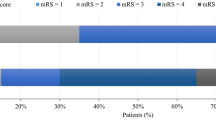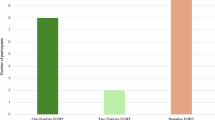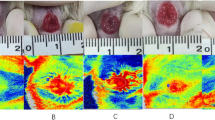Abstract
Study design
Pilot retrospective study on the outcome of open surgery for grade III and IV haemorrhoids in patients with SCI.
Objective
Haemorrhoids and anal fissures are common in patients with spinal cord injury (SCI). Grade I to III haemorrhoids are usually managed medically or by surgical ligation. Grade III and IV haemorrhoids are treated with surgical haemorrhoidectomy in the general population, but not in patients with SCI, most probably due to fear of complications.
Setting
Fondation Hopale, Berck-sur Mer, France
Methods
The surgical database was searched for open haemorrhoidectomies performed between 2007 and 2016. Seventeen patients were included. There were mostly males with complete paraplegia, mean age: 50 years and mean time since injury: 15.9 years. Open haemorrhoidectomy (Milligan and Morgan) was performed for isolated haemorrhoids (n = 4), and combined with Leopold Bellan procedure (posterior anoplasty and internal sphincterotomy) for associated anal fissures (n = 13). Short-term follow-up was performed by the surgeon (post-operative weeks 2 and 6), long-term follow-up by telephone interview (mean 5.7 years, SD 1.9).
Results
At 6-weeks post-operative, no significant complications had occurred and all wounds had healed, however 1 patient had recurrence of anal fissure. At long-term follow-up, 75% of patients reported a significant improvement in anorectal symptoms. Recurrences were reported by 5 patients: 3 haemorrhoids (18%) and 2 anal fissures (25%). Anal incontinence occurred in 1 patient who required an anal plug. All patients maintained the same bowel programs as pre-operative.
Conclusions
Open surgery procedures were well tolerated and should be considered in persons with SCI.
Similar content being viewed by others
Log in or create a free account to read this content
Gain free access to this article, as well as selected content from this journal and more on nature.com
or
References
Coggrave M, Norton C, Cody JD. Management of faecal incontinence and constipation in adults with central neurological diseases. Cochrane Database Syst Rev. 2014. Art. No. CD002115. https://doi.org/10.1002/14651858.CD002115.pub5.
Emmanuel A. Review of the efficacy and safety of transanal irrigation for neurogenic bowel dysfunction. Spinal Cord. 2010;48:664–73.
Krogh K, Nielsen J, Djurhuus JC, Mosdal C, Sabroe S, Laurberg S. Colorectal function in patients with spinal cord lesions. Dis Colon Rectum. 1997;40:1233–9.
Previnaire JG, Soler JM, Bordji H, Fiolet MC, Navaux MA, Mortier PE. [Assessment of severity of neurogenic bowel dysfunction in chronic patients with a simple 1-item questionnaire (PGI-S)]. Prog Urol. 2016;26:573–81.
Stone JM, Nino-Murcia M, Wolfe VA, Perkash I. Chronic gastrointestinal problems in spinal cord injury patients: a prospective analysis. Am J Gastroenterol. 1990;85:1114–9.
Cosman BC, Eastman DA, Perkash I, Stone JM. Hemorrhoidal bleeding in chronic spinal cord injury: results of multiple banding. Int J Colorectal Dis. 1994;9:174–6.
Wald A, Bharucha AE, Cosman BC, Whitehead WE. ACG clinical guideline: management of benign anorectal disorders. Am J Gastroenterol. 2014;109:1141–57.
Cosman BC, Cajas-Monson LC, Ramamoorthy SL. Twenty years of a veterans’ spinal cord injury colorectal clinic: flexible sigmoidoscopy and multiple hemorrhoid ligation. Dis Colon Rectum. 2017;60:399–404.
Scott D, Papa MZ, Sareli M, Velano A, Ben-Ari GY, Koller M. Management of hemorrhoidal disease in patients with chronic spinal cord injury. Tech Coloproctol. 2002;6:19–22.
Moult HP, Aubert M, De Parades V. Classical treatment of hemorrhoids. J Visc Surg. 2015;152:S3–9.
Viktrup L, Hayes RP, Wang P, Shen W. Construct validation of patient global impression of severity (PGI-S) and improvement (PGI-I) questionnaires in the treatment of men with lower urinary tract symptoms secondary to benign prostatic hyperplasia. BMC Urol. 2012;12:30.
Kirshblum SC, Burns SP, Biering-Sorensen F, Donovan W, Graves DE, Jha A, et al. International standards for neurological classification of spinal cord injury (revised 2011). J Spinal Cord Med. 2011;34:535–46.
Arnous J, Parnaud E, Denis J. [Safe hemorrhoidectomy. 3,000 operations]. Presse Med. 1971;79:87–90.
Bleday R, Pena JP, Rothenberger DA, Goldberg SM, Buls JG. Symptomatic hemorrhoids: current incidence and complications of operative therapy. Dis Colon Rectum. 1992;35:477–81.
Bouchard D, Abramowitz L, Castinel A, Suduca JM, Staumont G, Soudan D, et al. One-year outcome of haemorrhoidectomy: a prospective multicentre French study. Colorectal Dis. 2013;15:719–26.
Alexander MS, Biering-Sorensen F, Bodner D, Brackett NL, Cardenas D, Charlifue S, et al. International standards to document remaining autonomic function after spinal cord injury. Spinal Cord. 2009;47:36–43.
Krassioukov AV, Karlsson AK, Wecht JM, Wuermser LA, Mathias CJ, Marino RJ. Assessment of autonomic dysfunction following spinal cord injury: rationale for additions to International Standards for Neurological Assessment. J Rehabil Res Dev. 2007;44:103–12.
Cosman BC, Vu TT. Lidocaine anal block limits autonomic dysreflexia during anorectal procedures in spinal cord injury: a randomized, double-blind, placebo-controlled trial. Dis Colon Rectum. 2005;48:1556–61.
Lestar B, Penninckx F, Kerremans R. The composition of anal basal pressure. An in vivo and in vitro study in man. Int J Colorectal Dis. 1989;4:118–22.
Ganio E, Altomare DF, Milito G, Gabrielli F, Canuti S. Long-term outcome of a multicentre randomized clinical trial of stapled haemorrhoidopexy versus Milligan-Morgan haemorrhoidectomy. Br J Surg. 2007;94:1033–7.
Higuero T. Update on the management of anal fissure. J Visc Surg. 2015;152:S37–43.
Schornagel IL, Witvliet M, Engel AF. Five-year results of fissurectomy for chronic anal fissure: low recurrence rate and minimal effect on continence. Colorectal Dis. 2012;14:997–1000.
Krogh K, Christensen P, Sabroe S, Laurberg S. Neurogenic bowel dysfunction score. Spinal Cord. 2006;44:625–31.
Emmanuel AV, Chung EA, Kamm MA, Middleton F. Relationship between gut-specific autonomic testing and bowel dysfunction in spinal cord injury patients. Spinal Cord. 2009;47:623–7.
Acknowledgements
We are grateful to Johanna Robertson for revision of the English.
Author information
Authors and Affiliations
Corresponding author
Ethics declarations
Conflict of interest
The authors declare that they have no conflict of interest.
Rights and permissions
About this article
Cite this article
Previnaire, J., De Bont, N., Bordi, H. et al. Open surgery for haemorrhoids in persons with spinal cord injury. Spinal Cord Ser Cases 4, 35 (2018). https://doi.org/10.1038/s41394-018-0070-y
Received:
Revised:
Accepted:
Published:
DOI: https://doi.org/10.1038/s41394-018-0070-y



